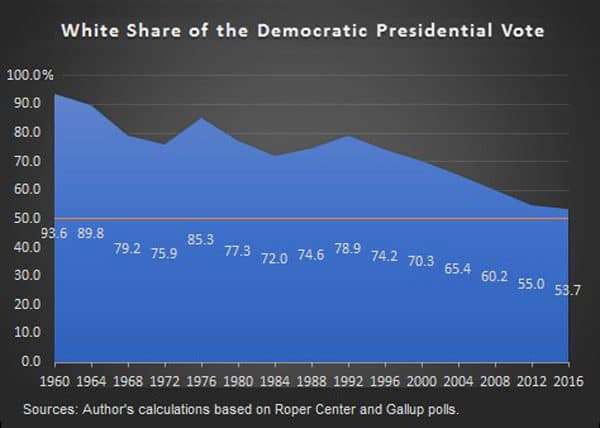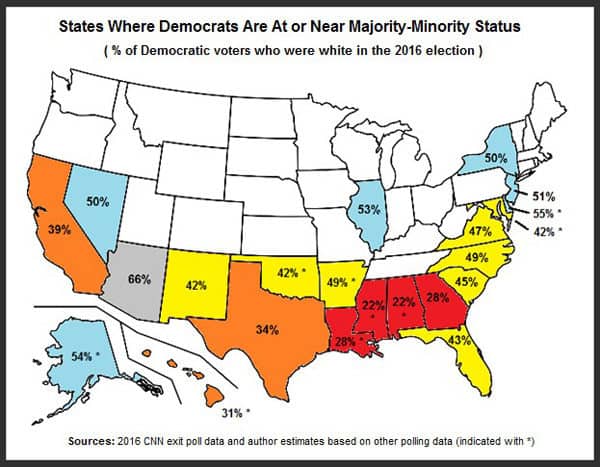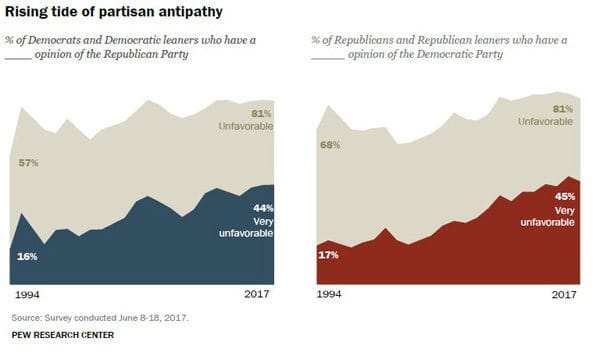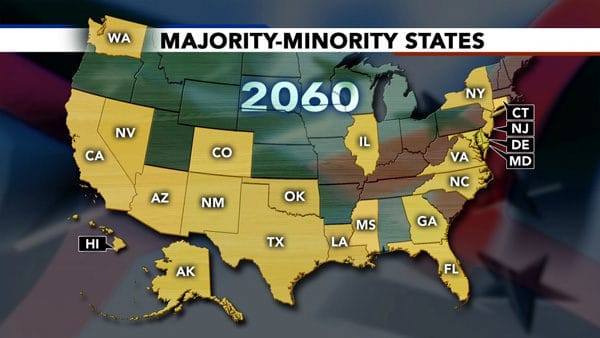America’s Coming Political Realignment
Patrick McDermott, American Renaissance, June 8, 2018
One of the most important looming events in American politics is the transformation of the Democrats into a majority-minority party. The Census Bureau predicts the United States will not become majority-minority until 2045, but the Democratic Party will reach that milestone 20 years early, possibly in 2020 but no later than 2024. Liberals have been confidently predicting an emerging and permanent Democratic majority, but they did not anticipate the white backlash this is producing. Both the Obama and Trump elections now appear to be harbingers of a new political realignment — one that will revolve increasingly around race.
Democrats: The emerging Majority-Minority Party
When he signed the Civil Rights Act of 1964, Lyndon Johnson famously said that the Democrats “have lost the South for a generation.” It was worse than he realized. Democrats lost not only the South; they lost the national white vote in every presidential election since Johnson beat Barry Goldwater that same year.
One could therefore argue that Republicans have been the de facto white party for half a century — except that white voters have been a majority of both national parties for this entire period. Neither party could afford to alienate whites because they comprised not just a majority in both parties, but also the all-important middle ground on which elections could be won or lost. Indeed, during the second half of the 20th century, no Democrat won the White House without either winning the white vote or at least a substantial part of it. Bill Clinton lost the white vote to George Bush by only 2 percent in 1992 and 1996, Jimmy Carter lost it by only 4 percent to Gerald Ford in 1976, Johnson won the white vote by a crushing 18 percent in 1964, and John F. Kennedy won it by 2 percent in 1960.
That changed in 2008. That year, Barack Obama won the presidency despite losing the white vote to John McCain by 12 percent. Four years later, he did even worse, losing the white vote to Mitt Romney by 20 percent. He was reelected anyway by a surge of non-white voters. In the last election, white voters backed Donald Trump by a similar 20-point margin.
However, the Democrats’ increased reliance on minority voters is a double-edged sword. The weakness of the theory of the inevitable Democratic majority was that it assumed white liberals would continue supporting Democrats by their earlier, historic margins. Instead, whites have been fleeing to the GOP. This, combined with continuing demographic change, has rapidly pushed the Democratic party toward majority-minority status.
For most of the late 20th century, white voters accounted for at least 70 percent of the Democratic presidential vote (see figure below), but that changed as America approached the 21st century. Since 1992, the white share of the Democratic vote has dropped about one percent per year, reaching 54 percent in 2016. At its present rate, the party could reach minority-majority status as soon as the next presidential election. It should do so no later than 2024.

The growing power of minority voters in Democratic Party politics
The results of this profound demographic shift have become apparent to anyone paying attention to politics. Today, no presidential candidate could hope to win the Democratic nomination by pushing a tough-on-crime, anti-welfare, and anti-immigration message, as Bill Clinton once did. Hillary Clinton practically shoved her husband off the stage during the 2016 election to avoid alienating key minority groups and white liberals.
Democratic presidential candidates are now heavily dependent on minority voters. Mr. Obama beat Mrs. Clinton for the 2008 nomination by trouncing her in the black vote. Mrs. Clinton did the same to Bernie Sanders in 2016, crushing him in the black and Hispanic vote. Non-whites were the central focus of her turnout efforts against Donald Trump.
This demographic reality is also affecting state-level races. In this year’s Georgia gubernatorial primary, Democrats supported a left-leaning black candidate, Stacey Abrams, over a more moderate white candidate by a margin of 3-to-1. In Texas, Democrats nominated a gay Hispanic woman for governor, Lupe Valdez. In New Mexico, Democrats chose the chair of the Congressional Hispanic Caucus. Arizona’s probable Democratic nominee is a Hispanic professor. Both of the top two Democratic candidates for governor in Maryland are black, and one is a former head of the NAACP.
Why the sudden surge in minority candidates? The answer is simple. While the national Democratic Party is only approaching minority-majority status, in many states the future has already arrived. Whites are now a minority among Democratic voters across most of the southern half of the country. Black voters are an outright majority of Democratic voters in Georgia, Alabama, Mississippi, and Louisiana. Hispanics are a plurality in New Mexico.

Republicans are becoming the Generic White Party
This year’s Democratic nominees are therefore not an anomaly; they are the party’s future. Minority voters in these states are doing what one would expect: nominating people like themselves. White flight from the Democratic Party speeds this transformation but also strengthens the Republican Party.
Thanks to strong white support, Republicans have won not just Congress and the presidency, but a large majority of governorships. This includes traditionally Democratic states such as Illinois and Maryland. In both states, most whites backed the Republican candidate and most non-whites voted for the Democrat. There have been similar results in the Midwest and even New England (though in the latter case, the Democrats’ far-left ideology, rather than race, was the determining factor). Astonishingly, the liberal bastion of Massachusetts has had just one Democratic governor in the past quarter century.
But these partisan shifts are also transforming the Republican party. Once the party of white conservatives, the GOP is now becoming the party of white people generally. Some sharp-eyed political analysts may have noticed that solid majorities of Republican voters do not support cuts in education, Social Security, and health care, and appear to offer only tepid and declining support for tax cuts.
This probably explains why Trump’s populist message helped him, even among Republican voters. Socially conservative Southern and prairie populists have a long history dating back to William Jennings Bryan and Andrew Jackson. These voters were once Democrats, but now they are Republicans — along with most of the rest of the white working class.
Of course, populism was only part of Trump’s appeal. Liberal political analysts frequently cite racism as the reason large majorities of whites twice voted against Barack Obama and went for Donald Trump in 2016. Stripped of value judgments, however, these analyses point to a different interpretation. Each of these elections reflected identity politics on both sides — something inevitable in an increasingly multiracial country.
Indeed, white voters are just beginning to mirror the lopsided support that minorities have given to Democrats for decades. Black voters routinely support Democrats at a rate of 90 percent. Hispanics and Asians commonly support Democrats at a rate of 65-70 percent. By contrast, white voters have supported Republican presidential candidates over the past three elections at a rate of only 55-59 percent. White polarization is still relatively modest.
That will almost certainly change. A major reason will be the continued, demographically-driven leftward tilt of the Democratic Party, but ideology will not be the only cause. Many white Americans imagine they are not like white Southerners, but the history of white backlash in Northern cities suggests otherwise. As they face the new demographic reality, their voting patterns will begin to resemble those of Southerners.
When America becomes majority-minority
All these trends can be expected to accelerate. Texas, California, New Mexico, and Hawaii have already reached majority-minority status in their overall populations. Other states projected to become majority-minority in the next few years include Nevada (2019), Maryland (2020), Arizona (2023), Georgia (2025), Florida (2028), and New Jersey (2028).
American elections will come down to one simple question: Which yields more votes — continued demographic change or white backlash? (In fact, this was the central issue of the last three presidential elections.) The answer may vary from year to year, but in the long run, demography is destiny.
Lee Kuan Yew, the former prime minster of Singapore, once said that in multiracial societies, politics do not reflect economic and social interests, but religion and race. Elections become racial/religious headcounts, and internationally and historically, identity politics are often played for keeps. Unsurprisingly, they are also playing a similar role in America, where a dangerous recent spike in polarization now has each party believing the worst of the other.

Some blame growing polarization on the power of the internet and the rise of media outlets such as Fox News. But this ignores the fact that Fox News tried to stop Donald Trump (as did the entire Republican party establishment) and failed. Something more powerful drives this divide.
Surveys by Pew suggest that the two primary causes, at least since 2014, have been differences over race and immigration. It is no accident that segregation in neighborhoods and schools has remained high during this period. And if race and immigration are major causes, the nation’s relentlessly changing demographics probably mean that polarization will become worse.
Finally, this growing divide is not just about politics and race, but increasingly about geography, with more and more counties overwhelmingly either Republican or Democrat. As the nation marches inexorably toward majority-minority status, this change will be especially noticeable in the southern half of the country.
Over the next few decades, the American southwest from California through Texas will become majority Hispanic. The old American South and much of the East Coast up through Connecticut will become majority-minority with large black populations in most cases. But most of the northern and central parts of the country will still be majority white.

Sources: PBS News Hour, Center for American Progress
Where will it end? The last time the United States was this profoundly divided by politics, geography, and the issue of race, there was secession. In 1861, the North stopped secession by force. If there should be similar division in the future, there may be no will to fight. If the white North wanted to secede, who in the new multicultural South would want to fight to preserve the Union, particularly when both sides increasingly dislike each other? Both sides would want independence. Some in both sections already do.
Under such circumstances, peaceful dissolution — the model followed in Czechoslovakia and the former Soviet Union — would be far preferable to the violent partition that occurred in Yugoslavia, India-Pakistan, or the War Between the States. Partition would be an important lesson for the rest of the Western world, much of which is facing its own looming demographic crisis.
People are more important than nations. Hard lessons are sometimes necessary for a people to survive.















